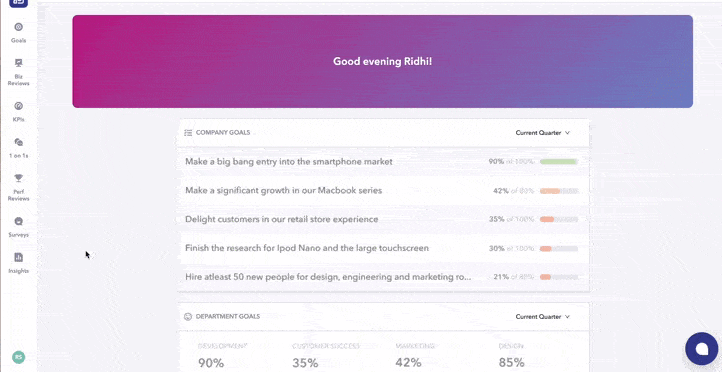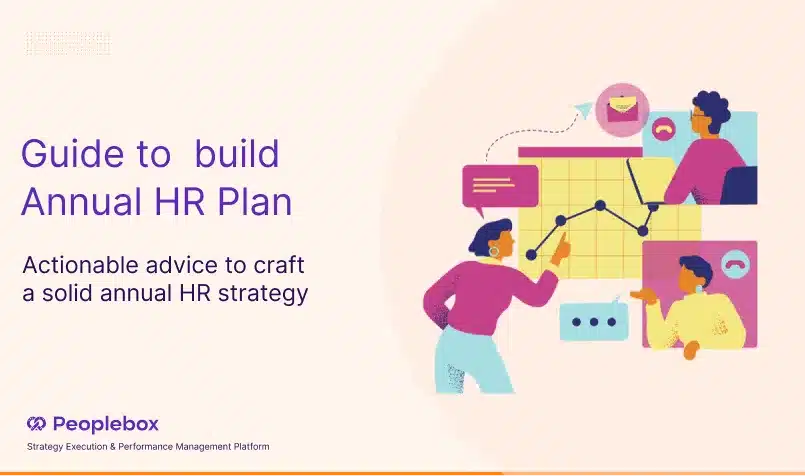At the start of each year, HR teams often have a mountain to climb—from recruiting new hires to reviewing employee performance and everything in between.
Things can quickly go south without a clear strategy to streamline these responsibilities.
The result? Poor employee retention, tanking employee satisfaction, and missed targets. You’ll end up scrambling to meet your quarterly goals and finish the backlog.
That’s why we’ve built this A-to-Z playbook to help you plan the entire year strategically. You’ll find clear monthly directives and timelines for managing everything on your plate without feeling overwhelmed.
A 12-month playbook for HR teams with solid annual HR plan
The start of a new year is a great opportunity to plan key HR activities and events and establish realistic timelines beforehand.
A 12-month HR plan essentially gives you a bird’s eye view of everything on your plate each month/quarter. This plan prepares the groundwork for better planning and stronger returns.
We’ve divided an HR team’s responsibilities into five main categories: goal setting, employee reviews, surveys, ongoing feedback, and new hire onboarding. Let’s break down the best practices to set timelines for each of these activities.

Goal setting
Execute in: January, April, July, and October
Goal setting is the process of brainstorming and outlining the shared objectives your team has to work toward. These objectives should align with your organization’s overall goals and drive business growth.
For example, if Company A wants to expand its market reach by 30% this year, the HR team has to set objectives to achieve this goal—like increasing the workforce by 20% and implementing employee training programs to support this company-wide goal.
While there’s no rinse-and-repeat blueprint for setting effective goals, these goal-setting best practices will help in building stronger alignment:
- Understand company objectives: HR teams should know the bigger picture. You need a nuanced understanding of your company’s overall goals to plan the roadmap for reaching these targets. So, engage in discussions with the upper management to get clarity on the organization’s directions and growth plans.
- Align with departmental goals: While setting goals for your team, you need to balance HR objectives with other departments’ targets. Whether it’s about hiring new talent or optimizing performance for the existing team members, you have to balance HR and team goals.
- Review and adapt: Setting goals isn’t a one-and-done exercise. You need to constantly review whether a goal is still relevant to your company or not. This review process also helps track progress and modify your strategy where relevant.
One of the keys to success with goal setting and alignment is how you communicate and track your goals. With a platform like Peoplebox, you can document your overall goals and break them down into specific timelines.
Peoplebox helps you map each goal to your employees and monitor progress in real-time. You can also integrate the tool with Slack to simplify communication and bring everyone on the same page.

Performance Reviews
Execute in: March, June, September, and December
HR teams conduct performance reviews to evaluate an employee’s contributions during a specific period and enhance performance through concrete and constructive feedback.
A good performance review process always involves self-assessment, where employees have to set goals for themselves at the start of the review period—like a new quarter. Then, they assess their own performance against these goals.
Remember that conducting continuous performance reviews every quarter is more beneficial than sharing reviews annually. This way, employees receive feedback consistently and are motivated to improve their skills.
More importantly, quarterly feedback fuels progress. Employees work on a <span”>few specific areas over three months instead of dividing their focus into too many areas of improvement.
As the HR, you have to create and follow a systematically structured framework to evaluate their performance against specific competencies.
Here’s a checklist to conduct employee performance reviews like a pro:
- Clearly outline and communicate the goals of each round of performance review
- Define the exact parameters and format for assessing employee performance
- Offer managers the right tools like Peoplebox to document and share feedback
- Share necessary documents or frameworks for self-assessment before the review
- Create a year-long timeline with key milestones and deadlines for performance review
Keep in mind that your performance review tasks will also change in different months.
For example, while March and September involve regular review months, June and December are specific review months where you share mid-year and end-of-year reviews. June is also the time for appraisals, PIP, or bonuses based on employee performance.
So, plan your review strategy accordingly!

Surveys
Execute in: February and August
Surveys give you a pulse of your employees. You can learn what’s fueling them, holding them back, creating frustration, and more. This directly helps introduce necessary changes in your people strategy to create a more conducive environment for your workforce to thrive.
Besides, employee surveys are a great channel to make your employees feel seen and heard, especially in a large team. When you act on specific feedback, you assure a team member that you’re committed to implementing their suggestions.
And surveys also uncover latent issues or challenges that may not be evident otherwise. So, you can take proactive action to tackle these problems.
To conduct a good employee survey, you need:
- Clarity on what you want to learn from the survey
- Relevant questions aligned with the survey’s purpose
- The ability to offer anonymity for getting honest responses
- A clear plan of action to analyze responses and implement changes
- A regular schedule for sending out these surveys and tracking improvements
Peoplebox’s automated engagement survey tool ticks all of these boxes! You can get started with any of the pre-made survey templates or create your own from scratch. It’s easy to schedule these surveys along with reminders to maximize participation.
The tool also lets you target specific groups or teams within your organization. And you can collect anonymous feedback to ensure complete confidentiality.
Once the survey responses are in, you can easily analyze and benchmark the results against industry performance to see where you stand.

Ongoing feedback
Execute in: Monthly
96% of employees say getting regular feedback helps them improve. Naturally, delivering regular feedback is a key responsibility for HR teams.
You have to conduct monthly feedback sessions to give employees a confidence boost and help them improve proactively. Research also shows that fast feedback can boost employee engagement by nearly four times. This fast feedback is delivered in a real-time context instead of a meeting.
Here are a few best practices to deliver ongoing feedback through peer reviews and monthly 1:1 syncs:
- Share specific points: Generic feedback like ‘good job’ helps nobody. For employees to truly embrace your feedback, you have to share concrete points of improvement with examples. Start with the positives, then tell them key areas of improvement. This gives them the feeling that you’ve actively monitored their performance across the month.
- Offer meaningful support: Feedback isn’t about sharing a list of pointers and calling it a day. You can make it more helpful by offering actionable tips and resources to work on the feedback points. Show employees you’re invested in their success.
- Have a two-way conversation: Create a conducive environment for employees to share feedback for you or the company. Give them the space to share what they like/dislike about the company, and what they expect to change.
HR teams can also share this ongoing feedback responsibility with team managers and conduct a joint discussion with each employee.

New hire onboarding
Execute in: 30-60-90 day plan
A fairly recurring responsibility for every HR team is recruiting and onboarding new employees. For every new hire, you need to implement a 30-60-90 day plan to familiarize them with your company and their roles.
Around 4 in 5 employees believe onboarding programs help them integrate and understand company culture. So, take this template to build your new hire onboarding plan today.
30-day phase
Help new hires understand their responsibility set and the company culture. You can start with a customized orientation schedule with a few icebreakers to brief them about the organization and know who they are.
It’s also a good practice to pair a new employee with a mentor or buddy to answer questions or address concerns quickly. Share a structured training plan with the employee to clarify their tasks and learning curve from the outset.
You can also schedule regular check-ins to monitor their progress and handle any issues. By the end of this phase, employees should have a comfortable relationship with others and understand the company’s goals.
60-day phase
In the next 30 days, you have to strengthen a new hire’s ability to perform in their role. This would involve designating progressive responsibilities to gradually get them started with different projects. You can also create feedback loops to share topical feedback and point out what they’re right/wrong.
You also need to identify specific areas where they can develop professionally and enroll them in relevant training programs.
By the end of this phase, new hires should start collaborating on projects and understand the business context of their role.
90-day phase
In the final phase, you have to actively involve new hires in strategic projects and give them the reigns to manage their work. By this phase, they’re fully integrated into the team and should start participating in performance reviews and long-term planning.
Create a strong foundation for your year with this playbook
That’s a wrap on our 12-month HR plan to efficiently manage all your activities and tasks!
Use this playbook to plan key events in each quarter and specific meetings every month. Once you’ve built this overall plan, it’ll be easier to identify exact dates for scheduling these events.
As a best practice, start by auditing your performance last year to discover the gaps you have to fill this year. Then, kick-start the planning process with this action plan. Don’t forget to check out Peoplebox to stay on top of your goals and maximize employee engagement.








